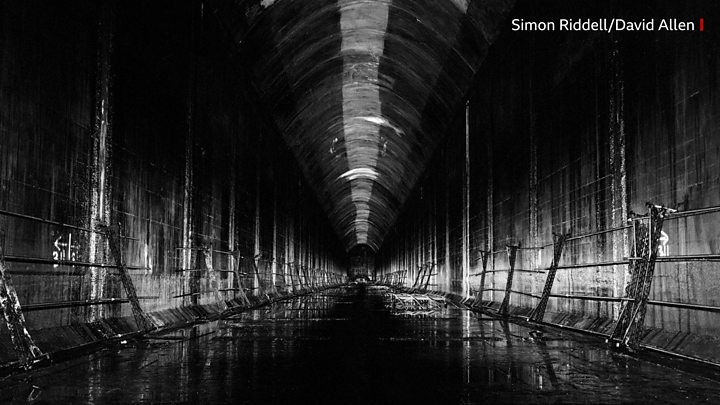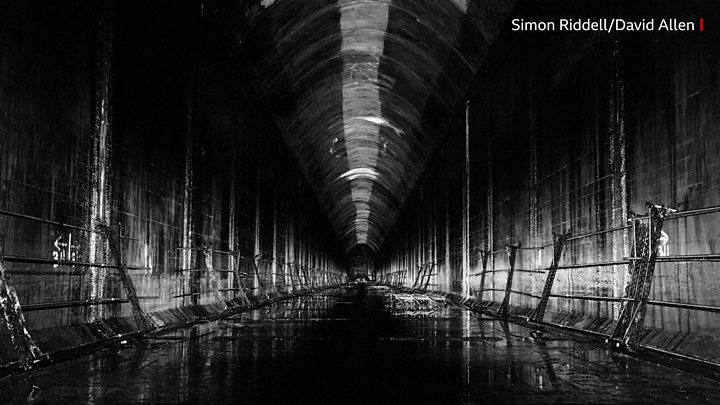Exploring The Tunnel: Scotland’s secret WW2 fuel depot
Two friends have documented their journey into a forgotten underground depot used during World War Two. …


Media playback is unsupported on your device
Beneath the hills of the Scottish Highlands lies one of the largest underground structures ever built by man.
Across Easter Ross it is known simply as The Tunnel.
Built between 1938 and 1941 for use during World War Two, the Inchindown oil storage facility is comprised of six monstrous tanks – 778ft long, 30ft wide and 44ft high.
The now-empty tanks are accessible by two tunnels – providing you can stomach the stench of oil vapour while navigating your way through complete darkness.
Photographers Simon Riddell and David Allen were thrilled at the prospect.
The two friends decided to explore The Tunnel as part of a project which would both stretch their physical limits and capture a piece of Scotland’s often-forgotten history.
The challenge: To take a single useable shot of tank one without digital technology, process and print the film negative on location – all while recording the experience for a documentary.
It not only meant they had to slide through a narrow pipe to get access to the tank – they also had to spend one eerie night camped underground.
Simon, 38, said: “I’ve been a firefighter so I’m no stranger to uncomfortable places. But there was one time where I wasn’t very comfortable.
“I had to take down all the gear before Dave arrived. I was using skateboards to transport things down, something made a noise and I just got a little bit worried.
“Even though you know you’re the only person there – you’ve locked yourself in – but you’re still in this dark, black place. It was a massive challenge.”
The idea for the project came from Simon, who moved from Warwickshire to Nigg in the Highlands with his family at age 18.
He soon discovered the numerous World War Two military installations scattered around the Cromarty Firth. Underground bunkers, tunnels, searchlight positions and gun emplacements all protected the British fleet from enemy attack.
The history on his doorstep captured his imagination – but Simon credits his late father Keith for nurturing his sense of adventure.
Simon said “My dad was the inspiration for the idea. One of his pastimes was photography – we’d go out on adventures and I’d start shooting too.
“He was a thrillseeker like me and we were very close. When he died I found that photography helped in taking me away from things.
“We’re dedicating the film to dad.”
As well as impaired vision, the structure of The Tunnel posed further problems for the two photographers.
The tanks, capable of holding 32 million gallons of fuel, were reported at full capacity during the Falklands – but are now empty. However, there are still signs warning any visitors to avoid all sources of ignition near the tanks in case of potential explosions.
Excavated below private land at Inchindown hill, the facility also had to be partly rebuilt following a number of rock falls. The terrain combined with oil residue resulted in some precarious navigation over slippery surfaces.
It was named among the acoustic wonders of the world by Smithsonian Magazine as it holds the record for the longest reverberation in any man-made structure – a factor that made communication incredibly difficult.
Simon said: “If you were talking to someone four metres away you struggled to understand them. Then when came out of tank we were both very cold – the shot itself took an hour to do.
“We were mentally exhausted after that and when came back to set up, we found we were talking a load of rubbish.
“Stuff that would sound easy to do we were struggling with – I’m not sure if it was sensory deprivation.”
Forgotten history
After serving its purpose The Tunnel was sold off in 1982. Plans to upgrade the depot for use by Nato were later abandoned and the site was closed by 2002.
Almost a decade later, guided tours of the facility were offered to the public and booked out within 90 minutes – they are no longer in operation and access is now controlled by a single keyholder.
The documentary One Shot: Inchindown chronicles Simon and Dave’s journey down into the darkness as they successfully develop their print from an 1860s-style camera.
Funded by the Port of Cromarty Firth’s community sponsorship programme, the film won ‘best documentary’ at the recent UK Monthly Film Festival.
The two friends hope their work might awaken interest in the secret depot once more.
David, 36, added: “Inchindown’s historical significance cannot be underestimated – the facility was absolutely crucial in the UK defences in World War Two.
“Many residents will know something of the above ground banks and some may know about Inchindown, perhaps with some having older relatives that may have worked on the project.
“But there really isn’t a lot of information available as regards a comprehensive tour that details both the raw infrastructure involved, and its purpose.”
The film will be screened in Inverness in November.




